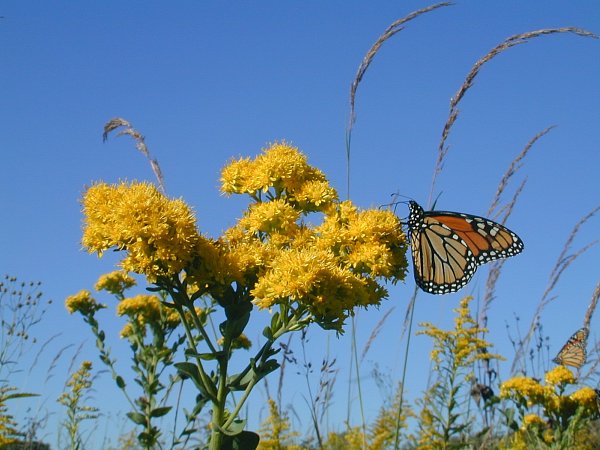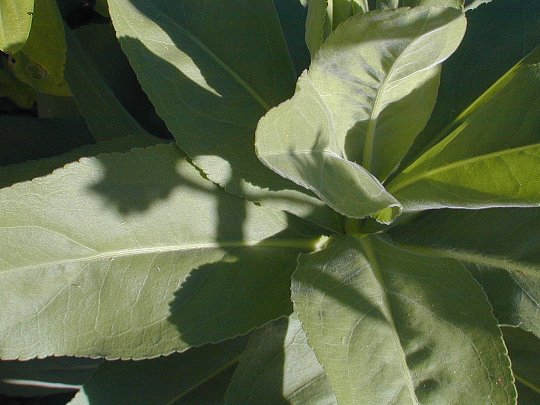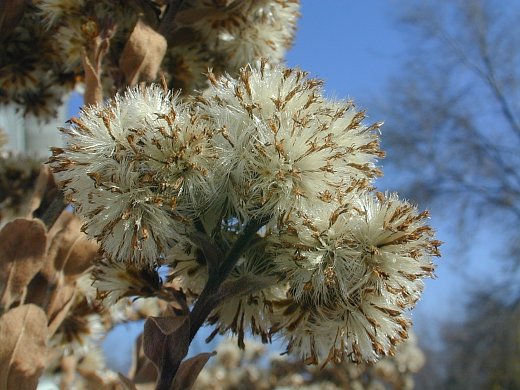Description: This perennial plant is 2-5' tall and unbranched, except near the inflorescence. The central stem is covered with fine white hairs. The basal leaves are up to 10" long and 5" wide, while much smaller leaves alternate upward along the central stem. These leaves are light green and pubescent; their margins are smooth or slightly serrated. They are variably shaped, appearing lanceolate, oblanceolate, oblong, or oval, but always with blunt tips. Initially, the leaves have a soft floppy texture, but they become more stiff later in the year. The basal leaves often persist through the winter and are semi-evergreen. At the apex of the central stem is a corymb of small yellow flowers. This inflorescence is about 2-4" across, while each flower is ¼–½" across. The upper side stems also produce corymbs of these flowers, which are more or less all bunched together. There is a mild floral fragrance. The blooming period occurs from late summer to fall, and lasts about a month. The achenes have small tufts of white or light brown hair, and are distributed by the wind. This plant has deep fibrous roots, and it has a tendency to form offsets.

Cultivation:
The
preference is full sun and moist to slightly dry conditions. This plant
is not particular about soil, which can consist of loam, clay-loam, or
gravelly material. There is a tendency to flop over during bloom if it
is spoiled by fertile soil or too much water. Powdery mildew sometimes
attacks the leaves. Drought resistance is good; some of the lower
leaves may wither away in response. This plant is easy to grow.
Range & Habitat:
The native Stiff Goldenrod occurs in most counties of Illinois and is
fairly
common, but it is rare or absent in parts of southern Illinois (see Distribution
Map). Habitats include moist to slightly dry black soil
prairies, clay prairies, savannas, thickets, limestone glades,
abandoned fields, roadsides, and open areas along railroads,
particularly where prairie remnants occur.

Faunal Associations: The flowers attract many kinds of insects, including long-tongued bees, short-tongued bees, wasps, flies, butterflies, and beetles. Monarch butterflies are especially attracted to the flowers. The larvae of several species of moths feed on various parts of this and other goldenrods (see Moth Table). Insects that are known to feed on Stiff Goldenrod specificially include larvae of Asteromyia carbonifera (Black Blister Gall Midge), Gnorimoschema gibsoniella (Twirler Moth sp.), and Tricholita notata (Marked Tricholita). The Greater Prairie Chicken and Eastern Goldfinch eat the seeds to a limited extent. Many mammalian herbivores eat this plant, particularly during the early stages of growth and development. This includes the White-Tailed Deer, Cottontail Rabbit, Muskrats, and livestock. The latter tend to leave this plant alone when there are other sources of food available. Where cattle graze in open fields, this plant is known as an 'increaser.'

Photographic
Location:
The photographs were taken at Meadowbrook Park in Urbana, Illinois, and
the wildflower garden of the webmaster in the same city.
Comments:
This is one of the more attractive goldenrods. It has a unique
appearance and is easy to distinguish from other goldenrods: 1) the
foliage is quite pubescent and light green, with a felty appearance; 2)
the basal leaves are quite large, assuming that they haven't withered
away; 3) the inflorescence consists of erect bunches of flowers; it
does not radiate outward, nor form a narrow wand; 4) the individual
flowers are slightly larger than those of other goldenrods. Along with
a few other goldenrod species, such as Riddell's Goldenrod and Ohio
Goldenrod, Stiff Goldenrod has been recently reassigned from the Solidago
genus to the Oligoneuron genus. Formerly, it was
referred to as Solidago rigida.